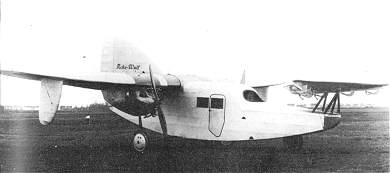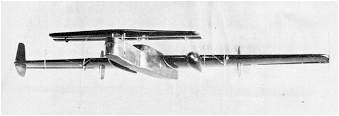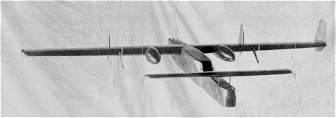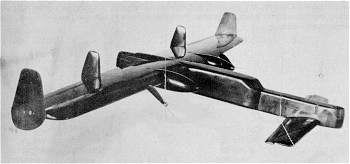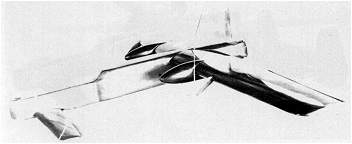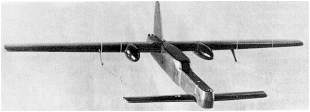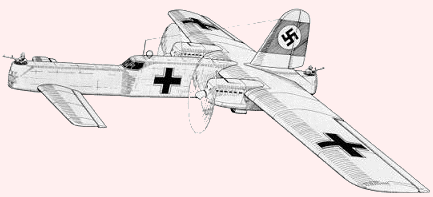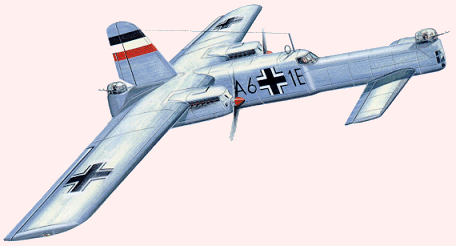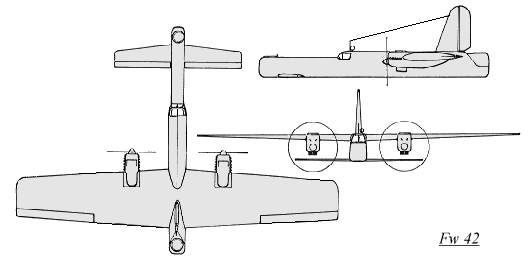 After receiving mostly positive results with his F 19 and F
19a "Ente" (Duck) light transport aircraft, Focke proceeded
to design a twin-engined "Ente" (Duck) bomber for the fledgling
Luftwaffe in 1931. This aircraft went through several design changes (January
13, 1932 - December 25, 1933), mainly concerning the placement of the front
horizontal tail (canard) and the rear vertical tail. The first design placed
the forward canard above the fuselage, and there were two fins and rudders
mounted on the each wing end, with two more fins along the wing trailing
edge outboard of the engine nacelles. Windtunnel tests showed that directional
stability was only slightly better with the four fins than a large single
vertical fin and rudder. Therefore, the decision was made to go with the
single large fin, due to the lower component cost and ease of construction.
Also, the forward canard was moved down to the fuselage bottom, thus improving
the pilot's view and the forward gunner's field of fire. On all versions,
the fuselage was narrow and long, with open MG firing stations in the extreme
nose and tail. Two BMW VIu 12 cylinder engines (750 horsepower for takeoff)
were mounted beneath each wing, and were provided with a four bladed propeller
of 3.8 m (12' 6") in diameter. The landing gear was retractable and the
cockpit was located approximately mid-fuselage, with the forward fuselage
stepped down in front of the cockpit. A crew of 6 was to man the Fw 42.
After receiving mostly positive results with his F 19 and F
19a "Ente" (Duck) light transport aircraft, Focke proceeded
to design a twin-engined "Ente" (Duck) bomber for the fledgling
Luftwaffe in 1931. This aircraft went through several design changes (January
13, 1932 - December 25, 1933), mainly concerning the placement of the front
horizontal tail (canard) and the rear vertical tail. The first design placed
the forward canard above the fuselage, and there were two fins and rudders
mounted on the each wing end, with two more fins along the wing trailing
edge outboard of the engine nacelles. Windtunnel tests showed that directional
stability was only slightly better with the four fins than a large single
vertical fin and rudder. Therefore, the decision was made to go with the
single large fin, due to the lower component cost and ease of construction.
Also, the forward canard was moved down to the fuselage bottom, thus improving
the pilot's view and the forward gunner's field of fire. On all versions,
the fuselage was narrow and long, with open MG firing stations in the extreme
nose and tail. Two BMW VIu 12 cylinder engines (750 horsepower for takeoff)
were mounted beneath each wing, and were provided with a four bladed propeller
of 3.8 m (12' 6") in diameter. The landing gear was retractable and the
cockpit was located approximately mid-fuselage, with the forward fuselage
stepped down in front of the cockpit. A crew of 6 was to man the Fw 42.
A full sized mock-up was built for the Fw 42, which was equipped with MG stations and control units. It was visited by the Russians and/or Japanese, for possible export license or production purchases. Although good results were reported from the windtunnel tests, a construction contract was not issued, so all work ceased on the Fw 42, which would have certainly been one of the most unusual bombers ever constructed.
As a historical note, almost the entire story of the Fw 42 would have been unknown except for a series of fortuitous events. In 1945, the Fw 42 file was forgotten in the evacuation of a shelter where Focke-Wulf had stored many of their documents. Moments later, this shelter was blown up in an attempt to hide any other data which could not be carried away. When the ruins of this shelter were being cleared 24 years later, Georg Graf zu Dohna, arranged with the excavators to pay attention in case anything of interest was uncovered. Incredibly enough, a file was soon uncovered which contained all the Fw 42 data, including photos and 12 windtunnel reports, and were almost completely undamaged, even though they had lain under the rubble for several decades!
